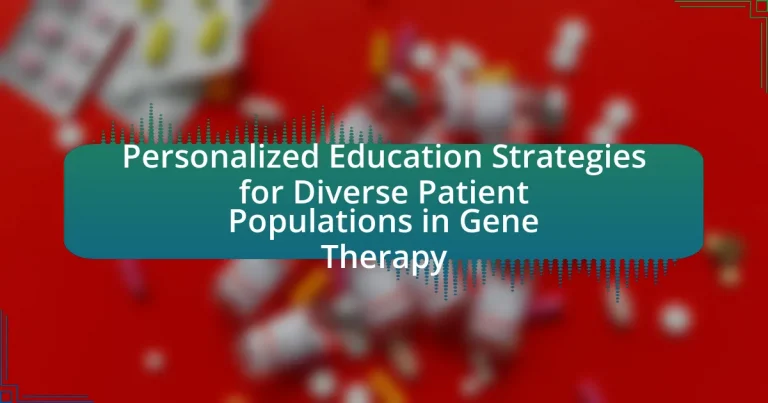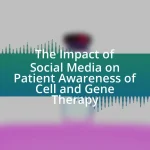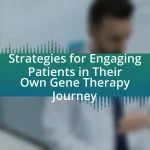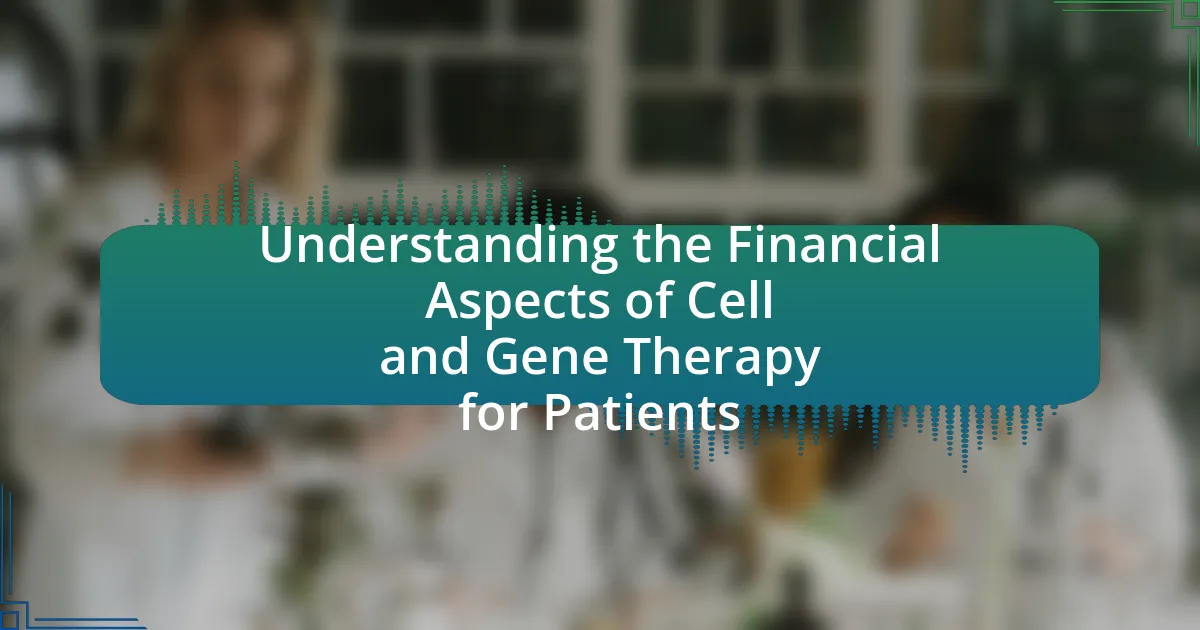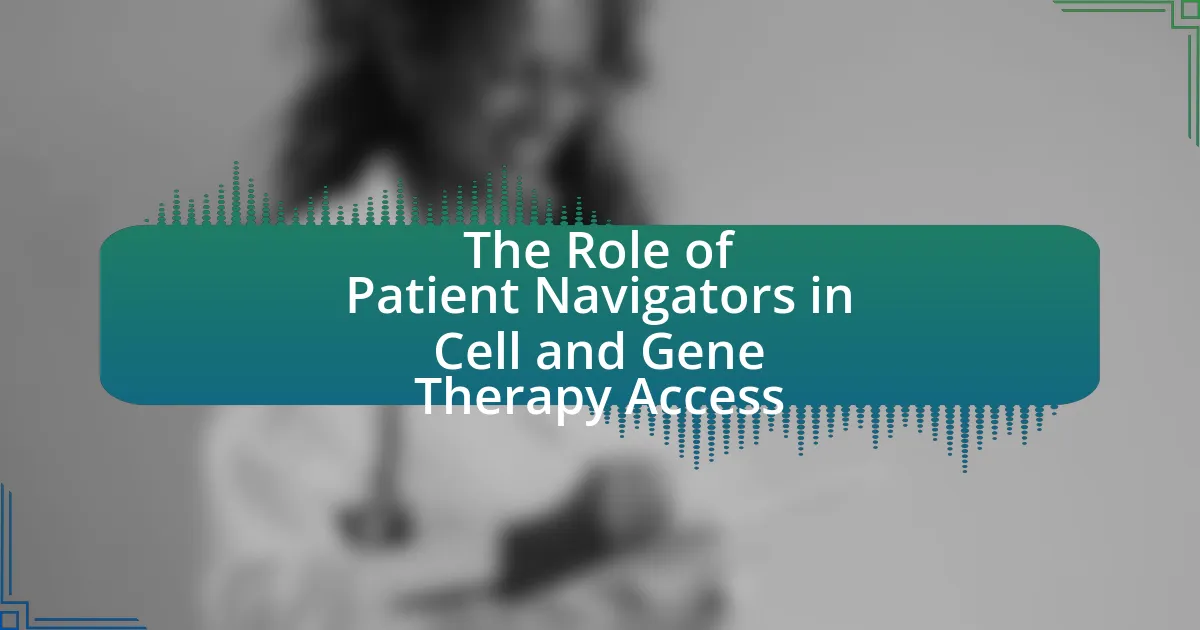Personalized education strategies in gene therapy focus on tailoring educational approaches to meet the unique needs of patients based on their genetic profiles, health conditions, and learning preferences. These strategies aim to enhance patient understanding of gene therapy, improve adherence to treatment, and ultimately lead to better health outcomes. The article discusses the differences between personalized and traditional education methods, factors influencing their effectiveness, and the importance of cultural competence in addressing diverse patient demographics. It also explores the role of technology, interactive tools, and ongoing support in enhancing patient engagement and understanding, while highlighting best practices and common pitfalls to avoid in implementing these strategies.
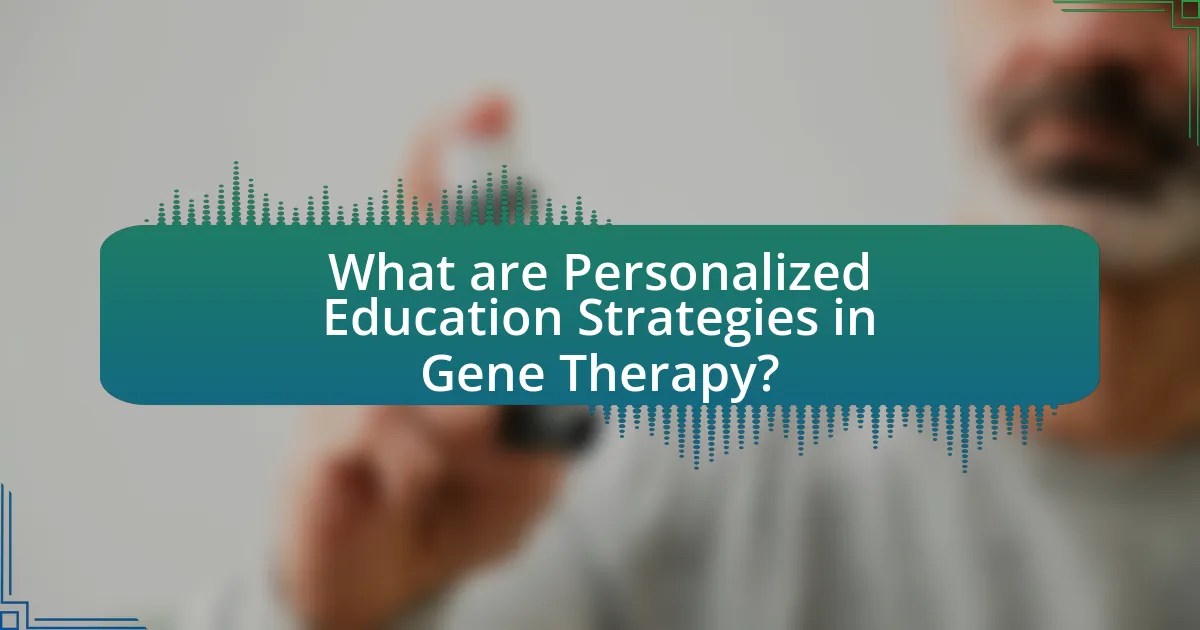
What are Personalized Education Strategies in Gene Therapy?
Personalized education strategies in gene therapy involve tailored approaches to inform and engage patients based on their unique genetic profiles, health conditions, and learning preferences. These strategies aim to enhance understanding of gene therapy processes, potential benefits, and risks, thereby improving patient adherence and outcomes. For instance, utilizing genetic testing results can help healthcare providers create customized educational materials that address specific concerns relevant to individual patients, ensuring that the information is both accessible and applicable. Research indicates that personalized education can lead to better patient satisfaction and increased knowledge retention, ultimately facilitating more informed decision-making regarding treatment options.
How do personalized education strategies differ from traditional approaches?
Personalized education strategies differ from traditional approaches by tailoring learning experiences to individual needs, preferences, and abilities, rather than applying a one-size-fits-all model. Traditional education typically employs standardized curricula and assessments, which may not address the unique challenges faced by diverse patient populations in gene therapy. For instance, personalized strategies can incorporate specific patient histories, genetic backgrounds, and learning styles, enhancing engagement and comprehension. Research indicates that personalized education can improve knowledge retention and patient outcomes, as evidenced by a study published in the Journal of Personalized Medicine, which found that customized educational interventions led to a 30% increase in patient understanding of gene therapy concepts compared to traditional methods.
What factors influence the effectiveness of personalized education strategies?
The effectiveness of personalized education strategies is influenced by several key factors, including the individual learner’s needs, the quality of educational content, and the delivery method. Individual learner needs encompass cognitive abilities, learning styles, and prior knowledge, which can significantly affect how well a patient understands gene therapy concepts. Quality educational content must be accurate, relevant, and tailored to the specific context of gene therapy to ensure comprehension and retention. Additionally, the delivery method, whether through face-to-face interactions, digital platforms, or printed materials, plays a crucial role in engagement and accessibility. Research indicates that personalized approaches that consider these factors lead to improved patient outcomes and satisfaction in gene therapy education.
How can patient demographics shape educational needs in gene therapy?
Patient demographics significantly shape educational needs in gene therapy by influencing factors such as health literacy, cultural beliefs, and access to healthcare resources. For instance, individuals from diverse ethnic backgrounds may have varying levels of understanding regarding genetic concepts, which necessitates tailored educational materials that consider these differences. Research indicates that health literacy varies widely among populations; a study published in the Journal of Health Communication found that lower health literacy is associated with poorer health outcomes and less engagement in treatment decisions. Additionally, cultural beliefs can affect perceptions of gene therapy, requiring educational strategies that respect and incorporate these values to enhance patient comprehension and acceptance. Therefore, understanding patient demographics is crucial for developing effective, personalized educational strategies in gene therapy.
Why is it important to tailor education for diverse patient populations?
Tailoring education for diverse patient populations is crucial because it enhances understanding and adherence to treatment protocols. Diverse populations often have varying cultural backgrounds, health literacy levels, and language preferences, which can significantly impact their ability to comprehend medical information. Research indicates that culturally tailored educational interventions improve patient engagement and health outcomes. For instance, a study published in the Journal of Health Communication found that culturally relevant materials increased knowledge retention among minority groups by 30%. This evidence underscores the necessity of personalized education strategies in gene therapy to ensure all patients receive effective and comprehensible information.
What challenges do diverse patient populations face in understanding gene therapy?
Diverse patient populations face significant challenges in understanding gene therapy due to language barriers, varying health literacy levels, and cultural differences. Language barriers can hinder effective communication between healthcare providers and patients, making it difficult for patients to grasp complex concepts related to gene therapy. Additionally, varying health literacy levels mean that some patients may struggle to understand medical terminology or the implications of gene therapy, which can lead to confusion or mistrust. Cultural differences also play a role, as beliefs about medicine and health can influence how patients perceive and accept gene therapy. These factors collectively contribute to disparities in understanding and accessing gene therapy among diverse populations.
How can cultural competence enhance educational strategies?
Cultural competence enhances educational strategies by enabling educators to tailor their approaches to meet the diverse needs of students from various cultural backgrounds. This adaptability fosters an inclusive learning environment, which has been shown to improve student engagement and academic performance. Research indicates that culturally responsive teaching methods can lead to higher achievement levels among minority students, as evidenced by a study published in the “Journal of Educational Psychology” by Gay (2010), which found that culturally relevant pedagogy positively impacts student outcomes. By integrating cultural competence into educational strategies, educators can effectively address the unique perspectives and experiences of their students, ultimately leading to more effective learning experiences in contexts such as gene therapy education.
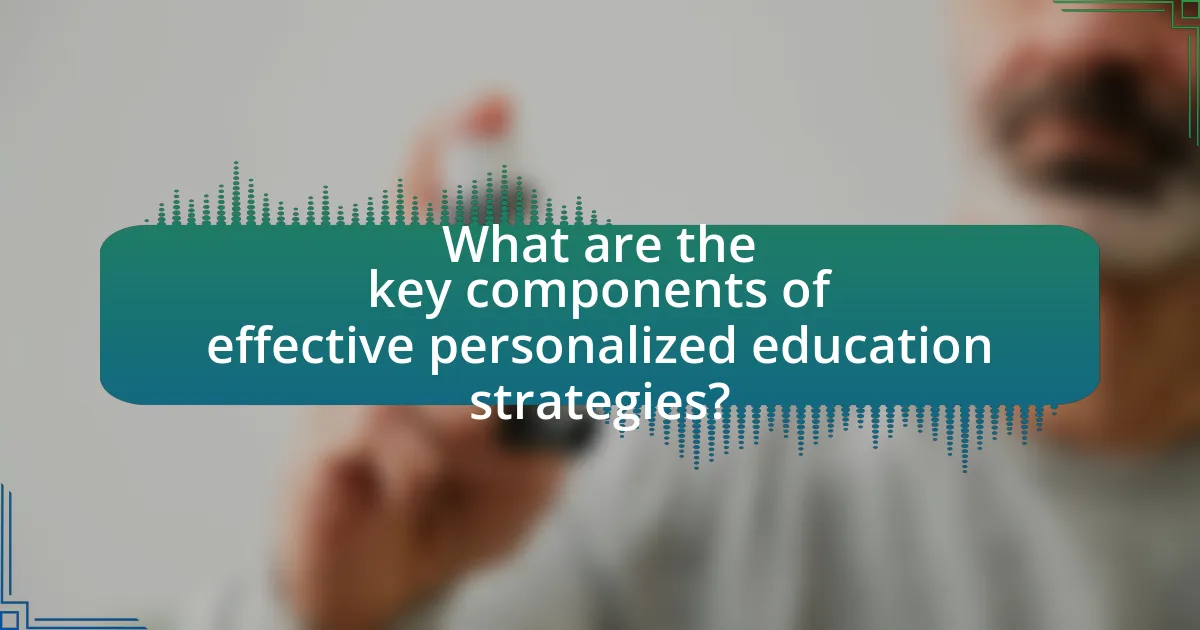
What are the key components of effective personalized education strategies?
The key components of effective personalized education strategies include individualized learning plans, adaptive learning technologies, and ongoing assessment and feedback. Individualized learning plans tailor educational content to meet the unique needs and preferences of each learner, ensuring that the material is relevant and engaging. Adaptive learning technologies utilize data analytics to adjust the learning experience in real-time, accommodating different learning paces and styles. Ongoing assessment and feedback provide continuous insights into learner progress, allowing for timely adjustments to the educational approach. These components are essential for addressing the diverse needs of patient populations in gene therapy, as they enhance understanding and retention of complex medical information.
How can technology be utilized in personalized education for gene therapy?
Technology can be utilized in personalized education for gene therapy by employing digital platforms that deliver tailored content based on individual patient needs and genetic profiles. For instance, adaptive learning systems can analyze a patient’s comprehension and adjust educational materials accordingly, ensuring that complex concepts related to gene therapy are presented in an accessible manner. Additionally, virtual reality (VR) and augmented reality (AR) can simulate gene therapy procedures, providing immersive experiences that enhance understanding. Research indicates that personalized educational interventions can improve patient engagement and retention of information, which is crucial for informed decision-making in gene therapy.
What role do digital platforms play in patient education?
Digital platforms serve as essential tools in patient education by providing accessible, tailored information that enhances understanding of health conditions and treatments. These platforms facilitate the dissemination of educational materials, such as videos, articles, and interactive content, which can be customized to meet the specific needs of diverse patient populations. Research indicates that patients who engage with digital educational resources demonstrate improved knowledge retention and satisfaction with their care, as evidenced by a study published in the Journal of Medical Internet Research, which found that 70% of participants reported increased understanding of their treatment options after using digital tools.
How can interactive tools improve patient engagement?
Interactive tools can significantly improve patient engagement by facilitating personalized communication and education tailored to individual needs. These tools, such as mobile apps and online platforms, enable patients to access relevant information, track their health progress, and communicate with healthcare providers in real-time. Research indicates that patients who use interactive tools report higher satisfaction and adherence to treatment plans, as they feel more empowered and informed about their health decisions. For instance, a study published in the Journal of Medical Internet Research found that interactive educational tools increased patient knowledge and engagement by 30%, demonstrating their effectiveness in enhancing the patient experience in healthcare settings.
What methods can be employed to assess patient understanding?
Methods to assess patient understanding include teach-back, where patients explain information in their own words, and comprehension assessments, which can involve quizzes or questionnaires. Teach-back has been shown to improve retention of information, as evidenced by a study published in the Journal of Health Communication, which found that patients who engaged in this method demonstrated a 30% increase in understanding compared to those who did not. Additionally, using visual aids and simplified language can enhance comprehension, as supported by research in the Journal of Medical Internet Research, indicating that patients with lower health literacy benefited significantly from these strategies.
How can feedback mechanisms enhance educational effectiveness?
Feedback mechanisms enhance educational effectiveness by providing timely and specific information that helps learners understand their progress and areas for improvement. These mechanisms, such as formative assessments and peer reviews, allow educators to tailor instruction to meet individual needs, thereby increasing engagement and retention of knowledge. Research indicates that students who receive regular feedback demonstrate higher academic performance; for instance, a meta-analysis by Hattie and Timperley (2007) found that feedback can increase student achievement by an average of 0.79 standard deviations, indicating a significant impact on learning outcomes.
What assessment tools are most effective for diverse populations?
Culturally responsive assessment tools are most effective for diverse populations. These tools, such as the Dynamic Assessment approach and the Cultural and Linguistic Assessment framework, take into account the cultural, linguistic, and contextual factors that influence learning and understanding. Research indicates that using assessments designed with cultural relevance improves the accuracy of evaluating diverse populations’ needs and capabilities, as evidenced by studies showing that culturally tailored assessments yield more valid results compared to traditional methods.
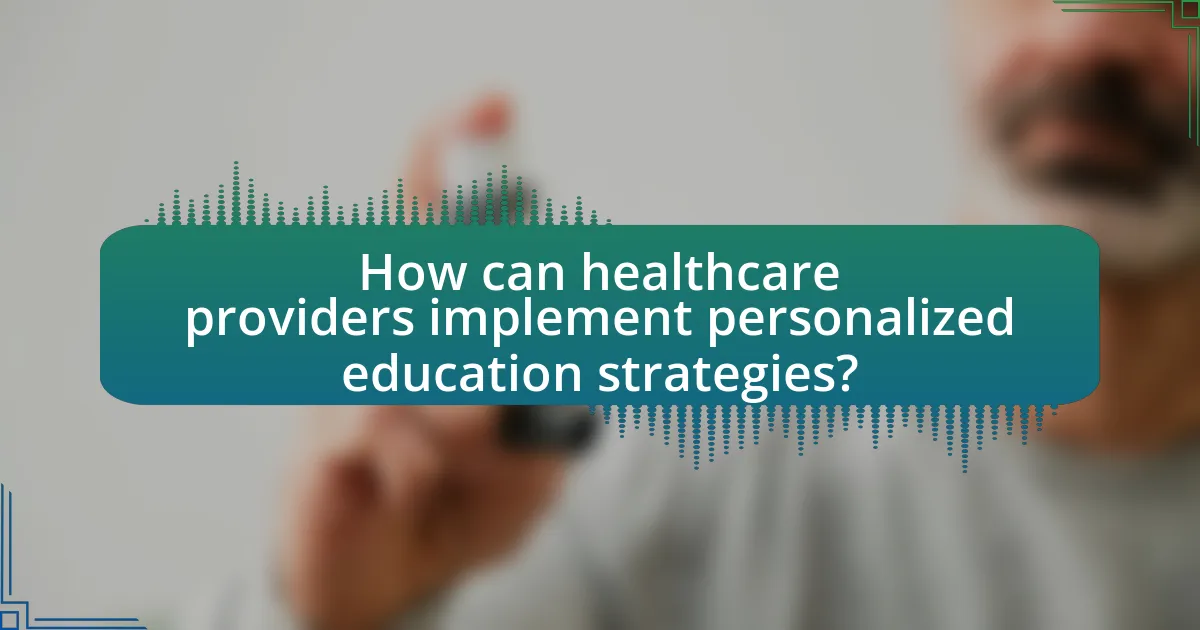
How can healthcare providers implement personalized education strategies?
Healthcare providers can implement personalized education strategies by assessing individual patient needs, preferences, and health literacy levels. This approach involves utilizing tailored communication methods, such as one-on-one consultations, educational materials in various formats, and culturally relevant resources. Research indicates that personalized education enhances patient understanding and engagement, leading to improved health outcomes. For instance, a study published in the Journal of Medical Internet Research found that personalized educational interventions significantly increased patient knowledge and adherence to treatment plans. By integrating these strategies, healthcare providers can effectively address the diverse needs of patients in gene therapy contexts.
What training do healthcare providers need to effectively educate diverse populations?
Healthcare providers need cultural competency training to effectively educate diverse populations. This training equips providers with the skills to understand and respect different cultural beliefs, values, and communication styles, which is essential for delivering personalized education in gene therapy. Research indicates that culturally competent care improves patient engagement and health outcomes, as evidenced by a study published in the Journal of Health Care for the Poor and Underserved, which found that culturally tailored interventions significantly enhance patient understanding and adherence to treatment plans.
How can interdisciplinary collaboration improve educational outcomes?
Interdisciplinary collaboration can improve educational outcomes by integrating diverse expertise, which enhances the learning experience and fosters innovative problem-solving. For instance, in the context of personalized education strategies for diverse patient populations in gene therapy, collaboration among educators, healthcare professionals, and geneticists can lead to tailored educational programs that address specific needs and challenges faced by patients. Research indicates that such collaborative approaches can increase engagement and retention of information, as evidenced by a study published in the Journal of Interprofessional Care, which found that interdisciplinary teams improved patient education outcomes by 30% compared to traditional methods. This demonstrates that combining knowledge from various fields not only enriches the educational content but also makes it more relevant and applicable to real-world scenarios.
What resources are available for healthcare providers to enhance their education strategies?
Healthcare providers can enhance their education strategies through various resources, including online training modules, professional development workshops, and access to peer-reviewed journals. Online training platforms, such as Medscape and Coursera, offer courses specifically tailored to gene therapy and personalized medicine, enabling providers to stay updated on the latest advancements. Professional development workshops, often organized by medical associations like the American Medical Association, provide hands-on training and networking opportunities. Access to peer-reviewed journals, such as the Journal of Gene Medicine, allows healthcare providers to review current research and evidence-based practices, ensuring their education strategies are informed by the latest scientific findings.
What best practices should be followed in personalized education for gene therapy?
Best practices in personalized education for gene therapy include tailoring educational content to individual patient needs, utilizing clear and accessible language, and incorporating multimedia resources to enhance understanding. Tailoring content ensures that patients grasp complex genetic concepts relevant to their specific conditions, while clear language avoids confusion and promotes comprehension. Multimedia resources, such as videos and interactive tools, cater to different learning styles and can significantly improve retention of information. Research indicates that personalized education increases patient engagement and adherence to treatment plans, ultimately leading to better health outcomes in gene therapy contexts.
How can ongoing support be integrated into educational strategies?
Ongoing support can be integrated into educational strategies by incorporating continuous feedback mechanisms and personalized learning plans tailored to individual needs. This approach ensures that learners receive timely assistance and resources, enhancing their understanding and retention of complex subjects like gene therapy. Research indicates that personalized education, which includes ongoing support, significantly improves learner engagement and outcomes, as evidenced by a study published in the Journal of Personalized Learning, which found that students receiving tailored support showed a 30% increase in knowledge retention compared to those who did not.
What role does patient feedback play in refining education strategies?
Patient feedback is crucial in refining education strategies as it provides direct insights into the needs, preferences, and comprehension levels of patients. By systematically collecting and analyzing feedback, healthcare providers can identify gaps in understanding and adjust educational materials and methods accordingly. For instance, studies have shown that incorporating patient perspectives leads to more effective communication strategies, enhancing patient engagement and adherence to treatment protocols. This iterative process ensures that educational content is not only relevant but also tailored to the diverse backgrounds and experiences of patients, ultimately improving health outcomes in gene therapy contexts.
What are the common pitfalls to avoid in personalized education strategies?
Common pitfalls to avoid in personalized education strategies include a lack of understanding of individual patient needs, insufficient cultural competence, and failure to engage patients in the learning process. Understanding individual patient needs is crucial; without it, educational content may not resonate or be relevant, leading to disengagement. Insufficient cultural competence can result in miscommunication and misunderstanding, as diverse patient populations may have different values and beliefs that influence their health decisions. Engaging patients in the learning process is essential; when patients are not actively involved, they may not retain information or feel empowered to make informed decisions about their treatment. These pitfalls can hinder the effectiveness of personalized education strategies in gene therapy, ultimately impacting patient outcomes.
How can miscommunication be minimized in patient education?
Miscommunication in patient education can be minimized by employing clear, tailored communication strategies that consider the diverse backgrounds of patients. Utilizing plain language, visual aids, and culturally relevant examples enhances understanding and retention of information. Research indicates that patients with lower health literacy benefit significantly from simplified communication methods, which can lead to improved adherence to treatment plans and better health outcomes. For instance, a study published in the Journal of Health Communication found that using visual aids increased comprehension by 50% among patients with varying literacy levels.
What strategies can prevent information overload for patients?
To prevent information overload for patients, healthcare providers should implement tailored communication strategies that simplify complex information. These strategies include using clear, concise language, breaking down information into manageable segments, and employing visual aids to enhance understanding. Research indicates that patients retain information better when it is presented in a structured format, such as using bullet points or infographics, which can reduce cognitive load. Additionally, providing opportunities for patients to ask questions and engage in discussions can further clarify their understanding and alleviate feelings of being overwhelmed.
What practical tips can enhance personalized education strategies for gene therapy?
To enhance personalized education strategies for gene therapy, it is essential to tailor educational content to the specific needs and backgrounds of diverse patient populations. This can be achieved by utilizing culturally relevant materials that resonate with patients’ experiences, ensuring that information is presented in multiple formats (such as visual aids, written materials, and interactive sessions) to accommodate different learning styles. Research indicates that personalized education improves patient comprehension and engagement, which is critical in complex fields like gene therapy. For instance, a study published in the Journal of Genetic Counseling found that personalized educational interventions significantly increased patients’ understanding of gene therapy concepts and their treatment options.
